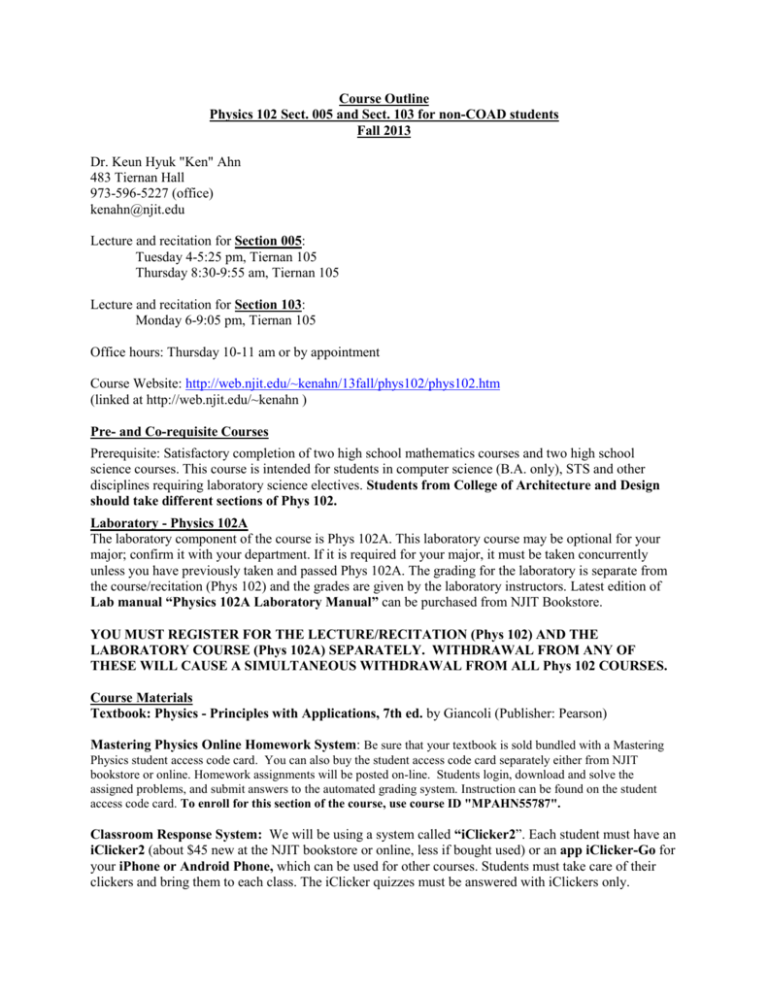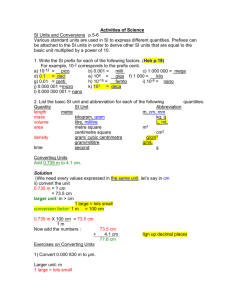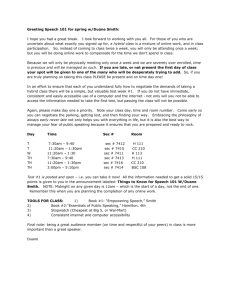Syllabus
advertisement

Course Outline Physics 102 Sect. 005 and Sect. 103 for non-COAD students Fall 2013 Dr. Keun Hyuk "Ken" Ahn 483 Tiernan Hall 973-596-5227 (office) kenahn@njit.edu Lecture and recitation for Section 005: Tuesday 4-5:25 pm, Tiernan 105 Thursday 8:30-9:55 am, Tiernan 105 Lecture and recitation for Section 103: Monday 6-9:05 pm, Tiernan 105 Office hours: Thursday 10-11 am or by appointment Course Website: http://web.njit.edu/~kenahn/13fall/phys102/phys102.htm (linked at http://web.njit.edu/~kenahn ) Pre- and Co-requisite Courses Prerequisite: Satisfactory completion of two high school mathematics courses and two high school science courses. This course is intended for students in computer science (B.A. only), STS and other disciplines requiring laboratory science electives. Students from College of Architecture and Design should take different sections of Phys 102. Laboratory - Physics 102A The laboratory component of the course is Phys 102A. This laboratory course may be optional for your major; confirm it with your department. If it is required for your major, it must be taken concurrently unless you have previously taken and passed Phys 102A. The grading for the laboratory is separate from the course/recitation (Phys 102) and the grades are given by the laboratory instructors. Latest edition of Lab manual “Physics 102A Laboratory Manual” can be purchased from NJIT Bookstore. YOU MUST REGISTER FOR THE LECTURE/RECITATION (Phys 102) AND THE LABORATORY COURSE (Phys 102A) SEPARATELY. WITHDRAWAL FROM ANY OF THESE WILL CAUSE A SIMULTANEOUS WITHDRAWAL FROM ALL Phys 102 COURSES. Course Materials Textbook: Physics - Principles with Applications, 7th ed. by Giancoli (Publisher: Pearson) Mastering Physics Online Homework System: Be sure that your textbook is sold bundled with a Mastering Physics student access code card. You can also buy the student access code card separately either from NJIT bookstore or online. Homework assignments will be posted on-line. Students login, download and solve the assigned problems, and submit answers to the automated grading system. Instruction can be found on the student access code card. To enroll for this section of the course, use course ID "MPAHN55787". Classroom Response System: We will be using a system called “iClicker2”. Each student must have an iClicker2 (about $45 new at the NJIT bookstore or online, less if bought used) or an app iClicker-Go for your iPhone or Android Phone, which can be used for other courses. Students must take care of their clickers and bring them to each class. The iClicker quizzes must be answered with iClickers only. NJIT is upgrading to the iClicker2 this semester. For this course, you may use older versions of iClickers, although other courses may require iClicker2. For those of you with iPhone or Android Phone, instead of buying the iClicker device, you can buy an app iClicker-Go for your iPhone or Android Phone, which will turn your iPhone or Android Phone into an iClicker. Consult the iClicker web page http://www1.iclicker.com/ for details. To create an account, you will need your student ID, which is your first name initial and last name without space or dot (Example: jdoe for John Doe). You will also need the school zip code, 07102. Email: NJIT email will be routinely used for announcements and to distribute material. Be sure check the NJIT email every day. Attendance Attendance at lectures and recitations is mandatory; it may constitute a portion of the final grade. Missing more than three lectures will be reported to the Dean of Freshman Studies throughout the semester and can result in failing the course. Students with absences need to discuss their extenuating circumstances for missing the classes with the Dean. Exams There will be three Common Exams and a Final Exam during the term. The exam schedule is: MondayCommon Exam 1: Monday, October 7, 4:15 – 5:45 pm Common Exam 2: Monday, November 4, 4:15 – 5:45 pm Common Exam 3: Monday, November 25, 4:15 – 5:45 pm Final Exam: To be announced There will be no makeup exams. Grading Final grades will be based on a composite score for the term’s work that includes three common exams, the final exam, homework score, written lecture quiz, iClicker quiz, and class participation. The approximate weights we expect to use in calculating the composite score are: 48 % for three Common Exams (16% for each) 33 % for Final Exam 12 % for Homework grade 7 % for iClicker quiz + Lecture Quiz + Class participation Extra credit may be given for active class participation, etc. Negative credit may be applied for lateness, creating noise, or otherwise interfering with class work. The cutoff percentages for various letter grades will be in the range of 84.0% for A, 76.0 % for B+, 68.0% for B, 60.0% for C+, 52.0% for C, 44.0% for D, F below 44.0 %. C or better grade is required to take further physics courses. If you get D in Physics 102, you cannot take the next level physics course. Reading Assignments The text readings are listed below. You should read the assigned sections of the text before the lecture covering that material. Homework It is almost impossible to succeed in this course without working a lot of problems: do the homework. Each student must download the weekly homework assignments from Mastering Physics online homework system, work the problems, and submit the solutions online before each assignment is due. Late work will not be accepted. See Course Materials section above. Attendance Attendance will be taken at all classes and exams. More than 3 unexcused absences from lecture is excessive and may result in a notification to the Dean. If you have excusable absences contact your instructor or the Dean of First year Students. If you withdraw from the course, do it officially through the Registrar; do not simply stop attending and taking exams. Students who withdraw unofficially force the instructor to assign a course grade of "F". Honor Code Violations or Disruptive Behavior NJIT has a zero-tolerance policy for cheating of any kind and for student behavior that disrupts learning by others. Incidents will be immediately reported to the Dean of Students. The penalties for violations range from a minimum of failure in the course with disciplinary probation up to expulsion from NJIT. Avoid situations where your own behavior could be misinterpreted, even if it is honorable. Students are required to agree to the NJIT Honor Code on each exam. Turn off all cellular phones, wireless devices, computers, and messaging devices of all kinds during exams. Please do not create noise in class that interferes with the work of students or instructors. Help Students are encouraged to meet with their instructor by arranging office visit. In addition, the Center for Academic and Professional Enrichment (CAPE) [http://www.njit.edu/cape/] located in Kupfrian 200, is open to all students and provides tutoring by experienced students. Learning Outcomes: For this course, you can expect to be assessed on the following learning outcomes: 1. Recall the definitions and relationships involving position, velocity, speed, acceleration, vectors, Newton’s Laws, circular motion, free-body diagrams, friction, work, energy, linear and angular momentum, torque, angular velocity and acceleration, and gravitation. 2. Apply the equations governing 1-D and 2-D constant acceleration to mechanical systems for various initial conditions. Calculate unknown quantities based on physical relationships, initial conditions, and known quantities. 3. Comprehend the meaning of the equations governing net force and acceleration (Newton’s Laws), and be able to manipulate them in conjunction with a free-body diagram to obtain any desired quantitative relationship. Understand the extension of these equations to rotational motion, and gravitation. 4. Generalize the concepts underlying the equations of motion, such as work, kinetic and potential energy, conservation of energy, and equilibrium. 5. Comprehend the meaning of equations governing momentum, impulse, and collisions. Apply the equations governing momentum, impulse, and collisions mechanical systems for various initial conditions. Understand under what conditions momentum is conserved and how to use this relation to calculate unknown quantities based on physical relationships, initial conditions, and known quantities. 6. Understand the extension of linear motion equations to rotational motion. Comprehend the meaning of the equations governing rotational motion and acceleration, and be able to manipulate them in conjunction with a free-body diagram to obtain any desired quantitative relationship. Course Schedule for Phys 102-005 (Tue/Thur class) Dates Lecture Topics Text Reading 9/3 T, 9/5 R Ch 1, Sec 1-6 9/10 T, 9/12 R Introduction Measurement and Units Motion in One Dimension Homework (Due dates posted on HW website) HW1 Ch 2, Sec 1-8 HW2 9/17 T, 9/19 R Vectors and Two-Dimensional Motion Ch 3, Sec 1-6 HW3 Ch 4, Sec 1-5 HW4 Ch 4, Sec 6-8 HW5 Ch. 1 - Ch.3 Ch. 6, Sec. 1, 3 HW6 11/4 M 11/5 T, 11/7 R The Laws of Motion - Forces and Newton’s Laws The Laws of Motion - Applications of Newton’s Laws Common Exam 1 (4:15-5:45pm) Energy -Work, Kinetic Energy, Work-Energy Theorem Energy -Potential Energy, Mechanical Energy, Energy conservation, Power Momentum and Collisions -Momentum, Impulse, Conservation of Momentum Momentum and Collisions -Collisions Common Exam 2 (4:15-5:45pm) Rotational Motion, Rotational Dynamics I 11/12 T, 11/14 R 11/19 T, 11/21 R 11/25 M Rotational dynamics II Static Equilibrium Common Exam 3 (4:15-5:45pm) Ch.8, Sec. 4-8 HW11 Ch. 9, Sec. 1-4 HW12 Ch. 7 - Ch. 8, Sec. 3 Ch. 5, Sec. 1-4 HW13 9/24 T, 9/26 R 10/1 T, 10/3 R 10/7 M 10/8 T, 10/10 R 10/15 T, 10/17 R 10/22 T, 10/24 R 10/29 T, 10/31 R 11/26 T (R schedule), 12/3 T 12/5 R, 12/10 T Date to be announced Circular motion The Law of Gravity Final Exam Ch. 6, Sec. 4-7, 9, 10 HW7 Ch. 7, Sec. 1-3 HW8 Ch 7, Sec. 4-8, 10 HW9 Ch. 4, Ch. 6 Ch 8, Sec 1-3 HW10 Ch 5, Sec. 5-8 Everything learned in class * The professor will discuss changes to the syllabus during class if they arise. HW14 Course Schedule for Phys 102-103 (Mon evening class) Dates Lecture Topics Text Reading 9/9 M Ch 1, Sec 1-6 9/16 M Introduction Measurement and Units Motion in One Dimension Homework (Due dates posted on HW website) HW1 Ch 2, Sec 1-8 HW2 9/23 M Vectors and Two-Dimensional Motion Ch 3, Sec 1-6 HW3 Ch 4, Sec 1-5 HW4 Ch. 1 - Ch.3 Ch 4, Sec 6-8 HW5 Ch. 6, Sec. 1, 3 HW6 Ch. 6, Sec. 4-7, 9, 10 HW7 Ch. 7, Sec. 1-3 HW8 Ch. 4, Ch. 6 Ch 7, Sec. 4-8, 10 HW9 11/11 M The Laws of Motion - Forces and Newton’s Laws Common Exam 1 (4:15-5:45pm) The Laws of Motion - Applications of Newton’s Laws Energy -Work, Kinetic Energy, Work-Energy Theorem Energy -Potential Energy, Mechanical Energy, Energy conservation, Power Momentum and Collisions -Momentum, Impulse, Conservation of Momentum Common Exam 2 (4:15-5:45pm) Momentum and Collisions -Collisions Rotational Motion, Rotational Dynamics I Ch 8, Sec 1-3 HW10 11/18 M 11/25 M Rotational dynamics II Common Exam 3 (4:15-5:45pm) Ch.8, Sec. 4-8 Ch. 7 - Ch. 8, Sec. 3 Ch. 9, Sec. 1-4 Ch. 5, Sec. 1-4 Ch 5, Sec. 5-8 Everything learned in class HW11 9/30 M 10/7 M 10/7 M 10/14 M 10/21 M 10/28 M 11/4 M 11/4 M 11/25 M 12/2 M 12/9 M Date to be announced Static Equilibrium Circular motion The Law of Gravity Final Exam * The professor will discuss changes to the syllabus during class if they arise. HW12 HW13 HW14









